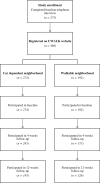The effect of neighborhood walkability on changes in physical activity and sedentary behavior during a 12-week pedometer-facilitated intervention
- PMID: 36455004
- PMCID: PMC9714904
- DOI: 10.1371/journal.pone.0278596
The effect of neighborhood walkability on changes in physical activity and sedentary behavior during a 12-week pedometer-facilitated intervention
Abstract
Background: Pedometer-facilitated interventions encourage physical activity via the accumulation of steps. Mixed evidence suggests that neighborhood walkability might influence the effectiveness of physical activity interventions, including pedometer-facilitated interventions. Our study investigated the moderating effect of neighborhood walkability on immediate (4-week) and short-term (12-week) changes in self-reported neighborhood-specific leisure and transportation walking, leisure-based moderate and vigorous-intensity physical activity, and leisure-based screen time during a pedometer-facilitated intervention (UWALK).
Methods: This quasi-experiment undertaken in Calgary (Canada) compared behavior changes during the 12-week intervention between two neighborhood groups classified as 'walkable' or 'car dependent' based on Walk Score®. Of the 573 volunteers (adults in the contemplation and preparation stages of physical activity behavior change), 466 participated in UWALK. Surveys captured sociodemographic characteristics, perceived neighborhood walkability, neighborhood preferences, motivation, physical activity and screen-based leisure. Covariate-adjusted linear mixed models estimated the differences in physical activity and leisure screen time between the neighborhood walkability groups at baseline, 4-weeks, and 12-weeks.
Results: UWALK participants included mostly females (83%) and had an average age of 49.2 years. Weekly minutes of walking for transport inside the neighborhood was higher (p < .001) among participants from walkable versus car dependent neighborhoods at baseline (42.5 vs. 21.1), 4-weeks (81.2 vs. 48.2), and 12-weeks (87.2 vs. 48.0). Regardless of neighborhood walkability, all physical activity outcomes were higher and leisure screen time lower at 4-weeks and 12-weeks compared with baseline. We found no significant neighborhood group by time interactions.
Conclusions: Pedometer-facilitated interventions may be effective for supporting short-term changes in physical activity and sedentary behavior even among adults residing in low walkable neighborhoods.
Copyright: © 2022 McCormack et al. This is an open access article distributed under the terms of the Creative Commons Attribution License, which permits unrestricted use, distribution, and reproduction in any medium, provided the original author and source are credited.
Conflict of interest statement
The authors have declared that no competing interests exist.
Figures
Similar articles
-
Associations between objectively-measured and self-reported neighbourhood walkability on adherence and steps during an internet-delivered pedometer intervention.PLoS One. 2020 Dec 3;15(12):e0242999. doi: 10.1371/journal.pone.0242999. eCollection 2020. PLoS One. 2020. PMID: 33270692 Free PMC article.
-
Neighbourhood urban form and individual-level correlates of leisure-based screen time in Canadian adults.BMJ Open. 2015 Nov 25;5(11):e009418. doi: 10.1136/bmjopen-2015-009418. BMJ Open. 2015. PMID: 26608640 Free PMC article.
-
Neighborhood Built Environment and Socioeconomic Status are Associated with Active Commuting and Sedentary Behavior, but not with Leisure-Time Physical Activity, in University Students.Int J Environ Res Public Health. 2019 Aug 31;16(17):3176. doi: 10.3390/ijerph16173176. Int J Environ Res Public Health. 2019. PMID: 31480418 Free PMC article.
-
Favorable Neighborhood Walkability is Associated With Lower Burden of Cardiovascular Risk Factors Among Patients Within an Integrated Health System: The Houston Methodist Learning Health System Outpatient Registry.Curr Probl Cardiol. 2023 Jun;48(6):101642. doi: 10.1016/j.cpcardiol.2023.101642. Epub 2023 Feb 10. Curr Probl Cardiol. 2023. PMID: 36773946 Review.
-
Walking: the first steps in cardiovascular disease prevention.Curr Opin Cardiol. 2010 Sep;25(5):490-6. doi: 10.1097/HCO.0b013e32833ce972. Curr Opin Cardiol. 2010. PMID: 20625280 Free PMC article. Review.
Cited by
-
Moving beyond biology: the critical role of social and structural determinants in atopic dermatitis.Int J Dermatol. 2025 Feb;64(2):272-281. doi: 10.1111/ijd.17491. Epub 2024 Sep 16. Int J Dermatol. 2025. PMID: 39282860 Free PMC article. Review.
-
Association between neighborhood environment and self-reported and objectively measured physical activity in Hispanic families.Front Sports Act Living. 2025 Jun 23;7:1560435. doi: 10.3389/fspor.2025.1560435. eCollection 2025. Front Sports Act Living. 2025. PMID: 40625887 Free PMC article.
-
The moderating impact of neighborhood walkability on mHealth interventions to increase moderate to vigorous physical activity for insufficiently active adults in a randomized trial.Int J Behav Nutr Phys Act. 2023 Aug 15;20(1):97. doi: 10.1186/s12966-023-01494-2. Int J Behav Nutr Phys Act. 2023. PMID: 37582736 Free PMC article. Clinical Trial.
-
Understanding the relationships between 24-hour movement behavior, community mobility and the neighborhood built environment for healthy aging in Brazil: The EpiMove study protocol.PLoS One. 2024 Dec 5;19(12):e0315021. doi: 10.1371/journal.pone.0315021. eCollection 2024. PLoS One. 2024. PMID: 39637080 Free PMC article.
References
-
- Murray JM, Brennan SF, French DP, Patterson CC, Kee F, Hunter RF. Effectiveness of physical activity interventions in achieving behaviour change maintenance in young and middle aged adults: A systematic review and meta-analysis. Soc Sci Med. 2017;192:125–133. doi: 10.1016/j.socscimed.2017.09.021 - DOI - PubMed
Publication types
MeSH terms
Grants and funding
LinkOut - more resources
Full Text Sources
Medical


